Worksheet Solutions: Rhythms of Nature | Our Wondrous World Class 5 - New NCERT PDF Download
Q1: Choose the correct option for each question.
(i) What is the name of the place in India known as the ‘First Village of the Sunrise’?
A) Khonoma
B) Dong
C) Thar Desert
D) Arunachal Pradesh
Ans: B) Dong Dong Valley (Arunachal Pradesh)
Dong Valley (Arunachal Pradesh)
(ii) How many seasons does India have according to the text?
A) Four
B) Five
C) Six
D) Seven
Ans: C) Six
(iii) Which season is associated with the festival of Diwali?
A) Spring
B) Summer
C) Monsoon
D) Autumn
Ans: D) Autumn
(iv) What activity helps students observe changes in nature throughout the year?
A) Nature Walk
B) Seasons' Journal
C) Drawing
D) Gardening
Ans: B) Seasons' Journal
(v) What do farmers in Odisha associate with the coming of rains?
A) Singing of the koel bird
B) Arrival of monsoon
C) Blooming of flowers
D) Changes in temperature
Ans: A) Singing of the koel bird
Q2: Match the items in Column A with the correct descriptions in Column B.
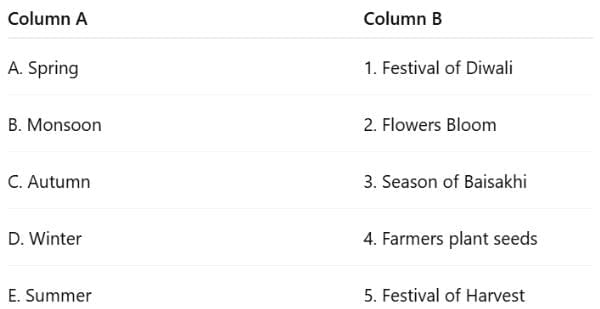
Ans: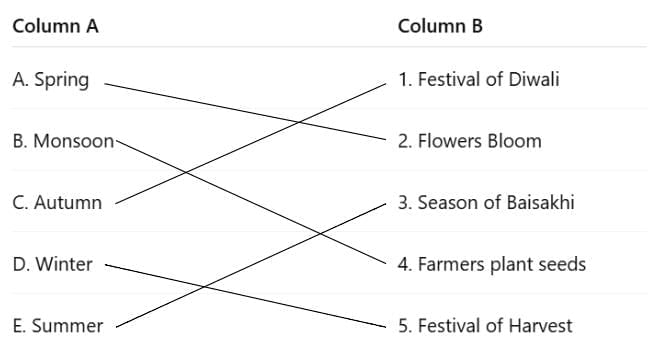
Q3: Fill in the blanks with the correct words from the chapter.
(i) The Earth rotates on its _____, causing day and night.
(ii) The _____ rises in the east and sets in the west.
(iii) In India, the season of _____ is when farmers plant seeds based on the koel's song.
(iv) _____ is celebrated in winter to mark the new year and harvest.
(v) The globe represents the _____ of the Earth.
Ans:
(i) The Earth rotates on its axis, causing day and night.
(ii) The sun rises in the east and sets in the west.
(iii) In India, the season of monsoon is when farmers plant seeds based on the koel's song.
(iv) Baisakhi is celebrated in winter to mark the new year and harvest.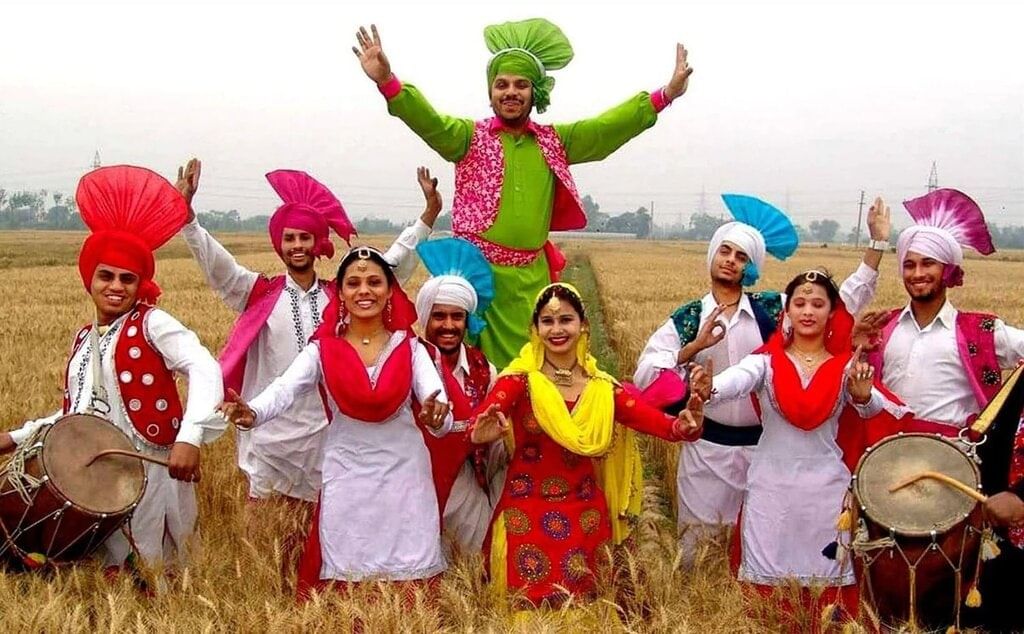 Celebrating baisakhi festival in Punjab(v) The globe represents the model of the Earth.
Celebrating baisakhi festival in Punjab(v) The globe represents the model of the Earth.
Q4: State whether the following statements are True or False. Correct the false statements.
(i) The sun rises in the west.
Ans: False
(ii) Diwali is a very special festival in India.
Ans: True
(iii) Seasons help us know how plants grow and how animals live.
Ans: True
(iv) There are five seasons recognised in India.
Ans: False
(v) The Thar Desert is known for its high rainfall.
Ans: False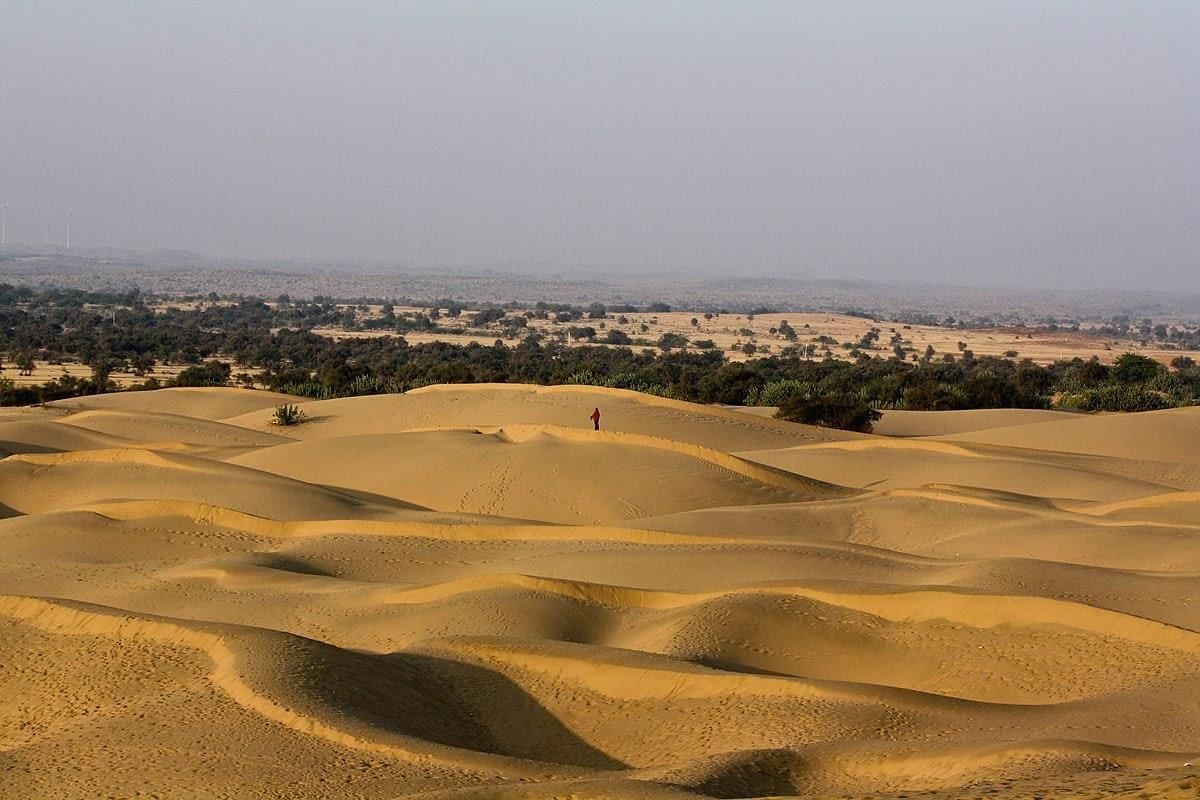 Thar Desert
Thar Desert
Q5: Answer the following questions in 2-3 sentences each.
(i) What changes did Saba and Aparna notice about themselves and their surroundings?
Ans: Saba and Aparna noticed that Saba is now taller than Aparna. They also saw new trees at their school and talked about changes in the classroom and their favourite games.
(ii) How does day change into night and night into day?
Ans: Day changes into night because the Earth rotates. When one side of the Earth faces the Sun, it is day, and when it turns away, it is night.
(iii) What is the significance of Dong in Arunachal Pradesh?
Ans: Dong is called India’s ‘First Village of the Sunrise’ because it is the first place in India where the sun’s rays touch the land every morning.
(iv) How can students observe changes in nature throughout the year?
Ans: Students can keep a journal to note changes in plants, animals, and weather. They can also make a chart to record their observations each season.
(v) Why are festivals important in seasons?
Ans: Festivals celebrate the changes in seasons and the crops grown during different times of the year. They connect people to nature and bring joy to their lives. Different festivals of India
Different festivals of India
Q6: Answer the following questions in 4-6 sentences each. Use examples from the chapter to support your answers.
(i) Explain how day and night occur. What causes this change?
Ans: Day and night happen because our Earth spins like a top. The Sun stays in one place and doesn't move around us.
- When our side of Earth faces the Sun, we get sunlight - this is daytime
- When our side faces away from the Sun, it becomes dark - this is nighttime
- Earth takes 24 hours to complete one full spin, giving us one day and one night
- We can understand this by using a torch (Sun) and a ball (Earth) - shine the torch on the ball and rotate it slowly
(ii) What are seasons? Name the six seasons of India and explain why seasons are important.
Ans: Seasons are repeating patterns of weather changes that happen every year in nature.
- India has six seasons: Vasanta (Spring), Grishma (Summer), Varsha (Monsoon), Sharad (Autumn), Hemant (Pre-winter), and Shishir (Winter)
- Seasons are important because they decide what crops farmers grow, what clothes we wear, and which festivals we celebrate
- They help plants and animals know when to bloom, migrate, or hibernate
- Seasons teach us that change is natural and necessary for life on Earth
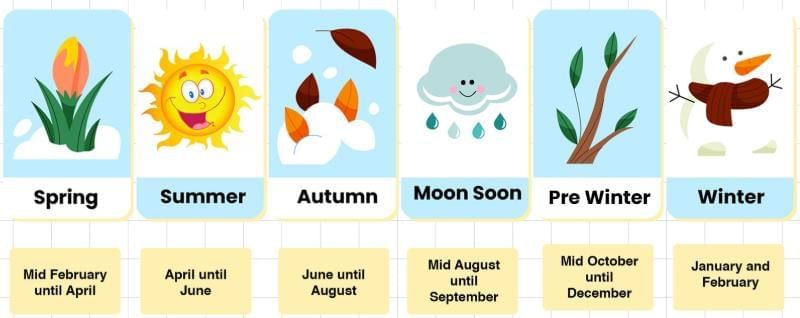
(iii) How do seasons affect human activities? Give examples of food, clothes, and festivals.
Ans: Seasons greatly influence what we do, eat, wear, and celebrate throughout the year.
- Food: We eat mangoes and cold drinks in summer, hot soups in winter, and fresh corn during monsoons
- Clothes: Cotton clothes in summer, woollens in winter, raincoats during monsoons
- Festivals: Holi in spring when flowers bloom, Diwali in autumn after harvest, Pongal in winter for celebrating crops
- Daily activities: Swimming in summer, staying indoors during heavy rains, enjoying bonfires in winter
(iv) Describe the classroom seasons chart activity. How does it help students understand seasonal changes?
Ans: The classroom seasons chart is a big wall chart that tracks changes throughout the year in an organised way.
- We divide the year into four periods: April-June, July-September, October-December, January-March
- Five themes are studied: plant life, birds and animals, air/heat/light, water bodies, and human activities
- Students share their journal observations and fill the chart together as a class
- Groups make posters showing how each theme changes through seasons, then present to classmates
- This activity helps us see patterns in nature and understand how everything is connected in seasonal cycles.
|
11 videos|212 docs|10 tests
|
FAQs on Worksheet Solutions: Rhythms of Nature - Our Wondrous World Class 5 - New NCERT
| 1. What are the main themes explored in "Rhythms of Nature"? |  |
| 2. How do seasonal changes affect wildlife and plant life? |  |
| 3. Why is it important to study the rhythms of nature? |  |
| 4. What role do humans play in the natural rhythms of the environment? |  |
| 5. How does the concept of biodiversity relate to the rhythms of nature? |  |
















